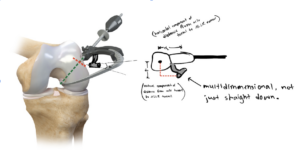*It is to note that all references from here on out regarding LET will be referred to as ALL. This change was made as LET does not reflect the work we have completed. ALL is a more broad term that encompasses our work
Evaluating and Redesigning Initial Prototypes: Addressing Flaws to Achieve Design Objectives
Based on the feedback from the alpha design review, as well as feedback from Dr. Grant, one of our primary stakeholders, the team decided not to pursue Oasis, the standalone device. We found that the standalone device was not logical, as clamping onto the outside of the legs would not be a viable option and would rather need two more portals and have to cut through important ligaments.
The two in one device, Dune, was recommended by Dr. Grant as well as from the design review and was chosen to further scrutinize as a higher fidelity prototype. This design involved a bar connecting the modeled handle of the device to the modeled measurement arm hook, however it was already known that this would not be a feasible solution when trying to achieve all functional requirements. The purpose of the bar was to allow for a mounting point from which the ALL drill slot could be located in order to achieve the correct trajectory. This would have to be redesigned and was the primary component of the creative design work necessary to build a successful prototype.

Example concept sketch of ALL arm extension design
There were a number of brainstorming sessions where designs were thought of in order to achieve the necessary 3-dimensional position, such as different-shaped extensions and sliders, and changing the mounting location of the bar. It was concluded that there was a general point in space relative to the trajectory of the ACLR drill slot where the ALL drill should begin in order to enter the femur in the correct location. Therefore, a simple rotating L-shaped attachment was chosen in order to achieve the necessary trajectory while not conflicting with the adjustable measurement arm hook’s movement.